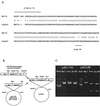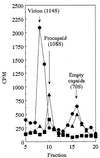Foreign and chimeric external scaffolding proteins as inhibitors of Microviridae morphogenesis
- PMID: 11000202
- PMCID: PMC112362
- DOI: 10.1128/jvi.74.20.9347-9352.2000
Foreign and chimeric external scaffolding proteins as inhibitors of Microviridae morphogenesis
Abstract
Viral assembly is an ideal system in which to investigate the transient recognition and interplay between proteins. During morphogenesis, scaffolding proteins temporarily associate with structural proteins, stimulating conformational changes that promote assembly and inhibit off-pathway reactions. Microviridae morphogenesis is dependent on two scaffolding proteins, an internal and an external species. The external scaffolding protein is the most conserved protein within the Microviridae, whose canonical members are phiX174, G4, and alpha3. However, despite 70% homology on the amino acid level, overexpression of a foreign Microviridae external scaffolding protein is a potent cross-species inhibitor of morphogenesis. Mutants that are resistant to the expression of a foreign scaffolding protein cannot be obtained via one mutational step. To define the requirements for and constraints on scaffolding protein interactions, chimeric external scaffolding proteins have been constructed and analyzed for effects on in vivo assembly. The results of these experiments suggest that at least two cross-species inhibitory domains exist within these proteins; one domain most likely blocks procapsid formation, and the other allows procapsid assembly but blocks DNA packaging. A mutation conferring resistance to the expression of a chimeric protein (chiD(r)) that inhibits DNA packaging was isolated. The mutation maps to gene A, which encodes a protein essential for packaging. The chiD(r) mutation confers resistance only to a chimeric D protein; the mutant is still inhibited by the expression of foreign D proteins. The results presented here demonstrate how closely related proteins could be developed into antiviral agents that specifically target virion morphogenesis.
Figures





References
-
- Burch A D, Ta H J, Fane B A. Cross-functional analysis of the Microviridae internal scaffolding protein. J Mol Biol. 1999;286:95–104. - PubMed
-
- Dokland T, McKenna R, Ilag L L, Bowen B R, Incardona N L, Fane B A, Rossmann M G. Structure of a viral assembly intermediate with molecular scaffolding. Nature. 1997;389:308–313. - PubMed
-
- Dokland T, Bernal R A, Burch A D, Pletnev S, Fane B A, Rossmann M G. The role of scaffolding proteins in the assembly of the small, single-stranded DNA virus φX174. J Mol Biol. 1999;288:595–608. - PubMed
Publication types
MeSH terms
Substances
LinkOut - more resources
Full Text Sources

